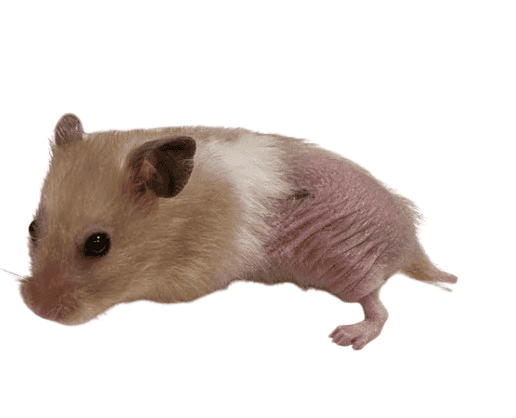Just recently studies started addressing Cushing’s Disease in hamsters, so it is no wonder owners don’t know much about it.
At the same time, the disease has similar symptoms to skin conditions and it is often misdiagnosed or attributed to aging.
To help you recognize the signs and understand Cushing’s Disease in hamsters, I’ll include symptoms, diagnosing procedures, causes, and prevention tips so you can treat your hamster early.
Let’s start.
Cushing’s Disease in Hamsters: Table of Contents
What is Cushing’s Disease in Hamsters?

Cushing’s Disease, also known as hyperadrenocorticism, is a condition where the adrenal glands produce too much cortisol (stress) hormone.
Cortisol is a hormone that is released in response to stress and is important for regulating blood sugar levels, blood pressure, and metabolism. However, when too much cortisol is produced, it can lead to various health problems, including Cushing’s Disease.
This overproduction of cortisol is often caused by a pituitary tumor or an adrenal tumor.
Types of Cushing’s Disease in Hamsters
Hyperadrenocorticism in hamsters can either be primary or secondary in origin.
Primary hyperadrenocorticism is the result of neoplastic changes (increased cortisol
production) in the adrenal cortex including a number of clinical and chemical abnormalities.
Secondary hyperadrenocorticism is the result of inappropriate secretion of ACTH (adrenocorticotropic hormone), usually by the anterior pituitary, resulting in increased cortisol
production and secretion by the adrenal cortex.
The term “Cushing’sdisease” has been applied to those cases of Cushing’s syndrome in which
hyperadrenocorticism is secondary in nature.
The Role of the Adrenal Glands
The adrenal glands are located above the kidneys and are responsible for secreting hormones, including cortisol.
The hypothalamus and pituitary gland in the brain help to regulate cortisol levels by releasing corticotropin-releasing hormone (CRH) and adrenocorticotropic hormone (ACTH).
When cortisol levels are too high, it signals the hypothalamus and pituitary gland to decrease CRH and ACTH production, which reduces cortisol production by the adrenal glands.
Causes of Cushing’s Disease in Hamsters
This disease is caused by an overproduction of cortisol, a hormone that regulates various body functions, including metabolism and immune response.
But the overproduction of cortisol is caused by:
- Tumors
- Genetic Factors
- Environmental Factors
- Age and Cushing’s Disease
Tumors
The overproduction of cortisol is often caused by a pituitary tumor or an adrenal tumor. Although these tumors are not brain tumors, they can still have serious implications for the hamster’s health because they affect the functioning of other organs in the body
Adrenal adenomas rank among the most common tumors of hamsters.
Studies conducted on hamsters showed that the inbred line of Syrian hamsters had a higher incidence of adrenal tumors in females and a high incidence of obesity.
Imaging shows an enlarged pituitary gland and a cystic dilated cleft.
Genetic Factors
Certain hamster breeds have a higher risk of developing Cushing’s Disease.
For example, dwarf hamsters are less prone to developing Cushing’s Disease than Syrian hamsters, but if they are exposed to other risk factors, they may still develop the condition.
Environmental Factors
Stressful living conditions or exposure to toxins can increase the risk of developing Cushing’s Disease in hamsters.
Hamsters are sensitive animals and can become stressed if they do not have enough space in their cage, are exposed to loud noises or bright lights, or do not have enough enrichment activities to keep them mentally stimulated.
If a hamster’s cage is not cleaned regularly, it can lead to the buildup of toxins, which can negatively impact its health.
Age and Cushing’s Disease
Cushing’s Disease is more common in older hamsters (senior rodents), typically those over two years of age. This is because the adrenal glands may become less responsive to regulation by the hypothalamus and pituitary gland as animals age, leading to the overproduction of cortisol.
Symptoms of Cushing’s Disease in Hamsters
There are several symptoms that hamster owners can look for that may indicate the presence of Cushing’s Disease. These symptoms include:
- Hair loss or thinning fur
- Scabby skin
- Hyperpigmentation (dark pigment patches on skin)
- Increased appetite and thirst
- Weight gain and obesity
- Reduced activity levels
- Frequent urination
- Enlarged abdomen
- Weakness or lethargy
Hair Loss and Skin Changes
When a hamster has Cushing’s disease, hair/fur loss progresses from the hind legs to the stomach to the whole body.
Hamsters with Cushing’s disease may develop thinner and more fragile skin, along with fatty deposits that resemble small tumor-like growths.
The excess cortisol in their bodies can cause proteins in the skin to break down, resulting in weaker blood vessels and easy bruising.
Hamsters with Cushing’s disease may not experience itchiness or scratching, which distinguishes it from other skin conditions or parasitic infestations
Treatment Options for Cushing’s Disease
The most common treatment is medication, which works to reduce cortisol production by the adrenal glands. This medication can be given orally or via injection, depending on the severity of the condition.
In some cases, surgery may be necessary to remove the affected adrenal gland. This is typically only done in severe cases where medication has not been effective.
PubMed Central published the study conducted on Three Teddy Bear Hamsters treated with Metyrapone and p’-DDD drugs.
The drugs were mixed in a corn syrup-water base and given orally in doses.
The hamster receiving metyrapone responded rapidly with hair growth in 12 weeks.
Hamster has continued to do well.
p’-DDD drugs didn’t show results due to dosage issues. Researchers couldn’t adjust the dosage.
Diagnosing Cushing’s Disease in Hamsters
Diagnosing Cushing’s Disease in hamsters is done through a combination of physical examination, blood tests, and imaging techniques.
Physical Examination
A veterinarian may perform a physical examination to check for any visible signs of Cushing’s Disease, such as hair loss or a distended abdomen.
Blood Tests
Blood tests can be used to measure cortisol levels in the bloodstream. In hamsters with Cushing’s Disease, cortisol levels are typically elevated. However, other conditions can also cause elevated cortisol levels, so additional tests may be necessary to confirm a diagnosis.
Imaging Techniques
X-rays or ultrasound scans are used to examine the adrenal glands for any abnormalities that may suggest the presence of Cushing’s Disease.
Cushing’s Disease in Hamsters Prevention
While there is no guaranteed way to prevent Cushing’s Disease in hamsters, there are several steps that owners can take to reduce the risk of their hamster developing the condition.
Diet
A healthy and balanced diet for hamsters includes a variety of fruits, vegetables, and high-quality hamster food.
Just like nutrition, fresh and clean water also plays a role in maintaining hamsters’ health.
Activity
Regular exercise is also important for maintaining your hamster’s overall health. Providing your hamster with a large and stimulating cage, filled with toys and climbing structures, can help to encourage exercise and activity.
Stress reduction
Stressful environments for hamsters include dirty cages, small cages, loud noises, overcrowding, too-hot or too-cold temperatures, etc.
Stress is the primary cause of almost all health conditions.
The easiest thing to do to help your hamster heal is to clean the cage and accessories, just temperature, isolate the hamster and try to lower the noise in the environment.
Vet Monitoring
Schedule regular check-ups with a veterinarian who specializes in exotic and small animals. They will be able to monitor your hamster’s health and catch any potential health problems early on.
My Senior Paws is a participant in the Amazon Services LLC Associates Program, an affiliate advertising program designed to provide a means for sites to earn advertising fees by advertising and linking to Amazon.com. We also participate in other affiliate programs which compensate us for referring traffic.




